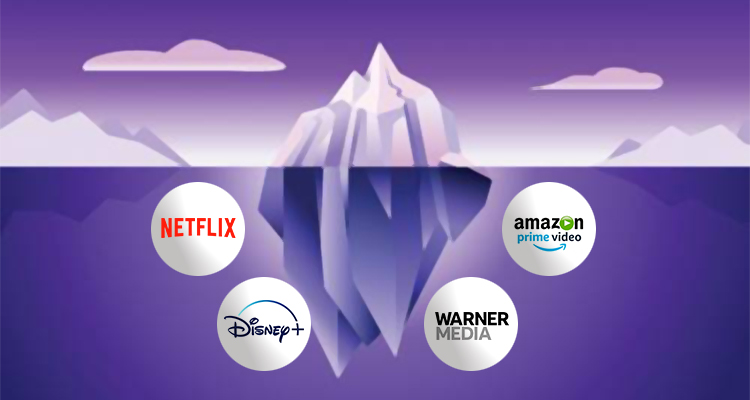La punta del Iceberg OTT

Los OTT son el gran segmento emergente hoy en día en el mercado de contenidos. Pero desde ya, no son un bloque homogéneo, y hay muchas tendencias cruzadas de unos a otros, que pueden definir mucho del futuro del negocio. Veamos…
Dentro del mapa OTT, hay 3-4 segmentos tomando fuerza, más allá de los titanes SVOD y AVOD, que hoy toman los grandes headlines:
—1) Los bundles, que son las alianzas con telcos, ISPs y cableoperadores para ser hub de conexión o incluso para hacer ofertas combinadas de varios OTT, como valor propio del ‘agregador’.
—2) Las estrategias ‘doble tier’, que llevan a un grupo a tener dos o más OTTs para captar, manejar mejor el mercado —Disney+ que lanza Star+ en junio a Latam.

—3) Desarrollos de ‘TV Everywhere’, donde grupos de canales como NBCUniversal en América Latina, lanzan ahora Universal+, usando a sus clientes de Pay TV como hub obligatorio, para ver el contenido en cualquier dispositivo online.
—4) Espacios como Olé Distribution, que engloba hoy a los canales Pay TV básicos del tradicional paquete HBO de América Latina que quedaron fuera de WarnerMedia —A+E, NBCUniversal, Warner, Sony— para ofrecer canales/contenidos lineales y no lineales a cableras, ISPs, telcos, de grandes a muy pequeños, para que armen sus propias programaciones OTT.
¿Qué valor generan estas opciones? 1) Los bundles no hace falta aclararlo, en los países desarrollados ya se han vuelto una forma clave de acceso cuando el mercado es híper competitivo. En América Latina ya se ven casos de ‘integradores de OTTs’ en México y Brasil.
2) El ‘doble tier’ responde a cuando hay mucho producto de distintos targets, y para tener mayor margen de maniobra comercial, sea por precio, o para hacer packs. También es un regreso a los comienzos del Pay TV, cuando las señales ícono se volvían grupos de señales para ocupar más mercado. Star+ seguramente será para Disney el Hulu & ESPN+ internacional. O puede mencionarse el caso de HBOMax, que en la región planea lanzar junto a su SVOD, un AVOD como ‘second tier’.
3) Los TV everywhere se separan de los OTT por ir sólo a través de cableoperadores, pero rápido pueden volverse nuevos OTTs si el mercado lo reclama. Universal+ se lanza con mucha fuerza masiva en la región.
Y 4) el movimiento de la Pay TV básica hacia lo digital de Olé es un mundo en si mismo, que sorprende a medida que uno se interioriza. Hay gran necesidad de contenido y ofertas, a cada paso de la cadena.
Por eso Prensario en sus ‘Protagonistas del Año’ de su edición de NATPE, destacó no sólo a los grandes OTT —Netflix, Amazon, Disney+, WarnerMedia— sino también a Marcello Coltro de NBCUniversal Channels o Juan Carlos Urdaneta de Olé Distribution. Hoy sólo se ve la punta del Iceberg OTT
What is the value of these options?
—The bundles don’t need to be clarify, in the developed markets they are a key way of access that makes the difference when the market is very competitive. In the emergent territories, they are just appearing, especially telcos or big cable operators switched to local OTTs.
—The ‘double tier’ strategies appear especially when the group handles too much product of different targets, and to have a broader commercial scenario, considering prices or special packs. It is also a return to the beginning of Pay TV business, when the big channels turned to group of channels, to occupy more market.
Star+ surely will be for Disney+ in the international market, the same that today Hulu and ESPN+ are at the U.S. domestic market. We can add the case of HBOMax, which is planning in many territories the launch of an AVOD system, as ‘second tier’ option to the main SVOD.
—The ‘TV everywhre’ developments are different from the OTT because they go to the market just through cable operators, but fast they can turn into a new OTT if the market requires that. In Latin America for instance, the ‘TV everywhere’ Universal+ has been launched with strong promotion this year, born from NBCUniversal Channels.
—The migration of the traditional, basic Pay TV sector to digital is a world itself, with many business options while you know more. There is a big need of content in all the output systems, especially the small and medium players.
That’s why Prensario, in its traditional ‘Protagonists of the Year’ selection at Natpe Miami, included not only the big OTTS as Netflix, Amazon, Disney+ or Paramount+, but also, these emergent traditional PayTV-to-OTT movements. Today, we see just the tip of the OTT iceberg, with a lot new and unexpected to come.
Por Nicolás Smirnoff


